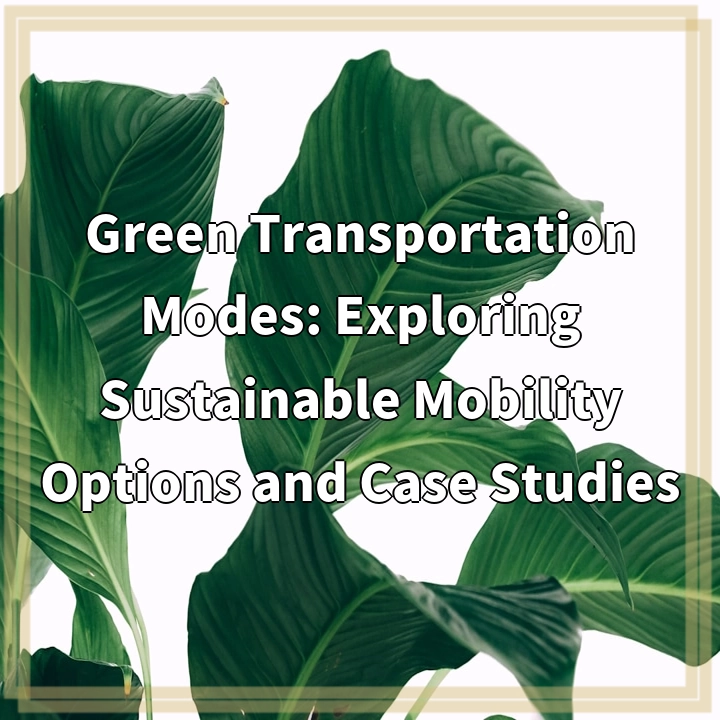
What is Green Transportation Modes?
Green transportation modes refer to sustainable and eco-friendly options for moving people and goods from one place to another. These modes prioritize reducing carbon emissions, minimizing environmental impact, and promoting more efficient use of resources. By utilizing cleaner and greener technologies, these transportation modes aim to mitigate the negative effects of traditional transportation systems on the environment and human health.
Real-World Problems Associated with Green Transportation Modes
While green transportation modes offer numerous benefits, they also face challenges and obstacles in their widespread adoption. Some of the key real-world problems associated with these modes include:
1. Infrastructural Limitations
One major issue is the limited infrastructure and support for green transportation modes. For example, the lack of comprehensive networks of bike lanes and pedestrian-friendly pathways in cities can discourage people from choosing cycling or walking as their primary mode of transportation. Similarly, the lack of charging stations and efficient public transportation systems for electric vehicles can hinder their adoption and usage.
2. High Initial Costs
Green transportation options often come with higher upfront costs compared to traditional alternatives. Electric vehicles, for instance, can be more expensive than conventional petrol or diesel cars. Additionally, the infrastructure required to support electric vehicles, such as charging stations, can also entail significant investments. These higher costs can act as a deterrent for individuals and businesses considering green transportation options.
3. Resistance to Change
Many people are resistant to change and may hesitate to switch from familiar, traditional transportation methods to newer, greener options. This resistance can be due to a lack of awareness, skepticism about the performance and reliability of green transportation modes, or a perceived inconvenience in changing habits and routines. Overcoming this resistance and fostering a culture of sustainability and eco-consciousness is crucial for promoting the adoption of green transportation modes.
4. Limited Range and Accessibility
One challenge faced by certain green transportation modes, such as electric vehicles and bicycles, is their limited range and accessibility. Electric vehicles may have limited driving range compared to vehicles fueled by petrol or diesel, requiring more frequent charging and potentially causing range anxiety for users. Similarly, the availability of bike-sharing and scooter-sharing programs may be limited to certain areas, making them less accessible and convenient for everyone.
5. Infrastructure Integration
Integrating green transportation modes into existing transportation infrastructure can be complex and challenging. It requires careful planning and coordination to accommodate modes such as cycling, walking, or electric vehicles alongside conventional transportation systems. This includes designating dedicated lanes, installing charging stations, and ensuring seamless connectivity between different modes of transport. Lack of proper integration can hinder the overall effectiveness and efficiency of green transportation systems.
These are just a few of the real-world problems that need to be addressed in order to fully realize the potential of green transportation modes. By recognizing these challenges and actively working towards solutions, we can create a more sustainable and environmentally friendly transportation system.

Solutions to Real-World Problems
Addressing the real-world problems associated with green transportation modes requires proactive measures and collaborative efforts. Here are some potential solutions:
1. Infrastructure Development
Investing in the development of infrastructure is crucial to support and encourage green transportation modes. This includes expanding and improving bike lanes and pedestrian pathways, constructing charging stations for electric vehicles, and enhancing public transportation systems. Governments, city planners, and transportation authorities need to prioritize the creation of a comprehensive network that promotes and facilitates the use of sustainable transportation options.
2. Financial Incentives
To overcome the high initial costs of adopting green transportation modes, governments and organizations can provide financial incentives. This can include tax credits for purchasing electric vehicles, subsidies for public transportation fares, and grants for building charging infrastructure. By reducing the financial burden, these incentives can make sustainable transportation options more accessible and appealing to a wider range of individuals and businesses.
3. Education and Awareness
Promoting education and awareness about the benefits of green transportation modes is key to overcoming resistance to change. Educational campaigns can highlight the positive environmental and health impacts, the long-term cost savings, and the improved quality of life that comes with adopting sustainable transportation options. By increasing public understanding and acceptance, individuals can make more informed choices that contribute to a greener and more sustainable future.
4. Technological Advancements
Continued research and development of green transportation technologies is essential for overcoming the limitations of current modes. Advancements in battery technology can extend the range of electric vehicles, while innovations in renewable energy can power more sustainable transportation options. Additionally, improvements in data analytics and transportation planning software can help optimize routes and enhance the efficiency of public transportation systems.
5. Policy and Regulation
Government policies and regulations play a crucial role in promoting the adoption of green transportation modes. Measures such as stricter emissions standards, incentives for eco-friendly vehicles, and zoning regulations that prioritize non-motorized transportation can help create a more supportive environment for sustainable transportation options. Collaborating with stakeholders and including sustainability goals in transportation planning can ensure that policies are effectively implemented and monitored.
By implementing these solutions, we can address the real-world problems associated with green transportation modes and pave the way for a more sustainable and eco-friendly transportation system.















